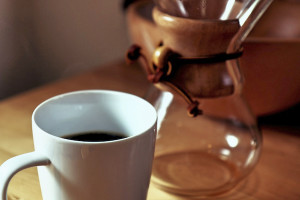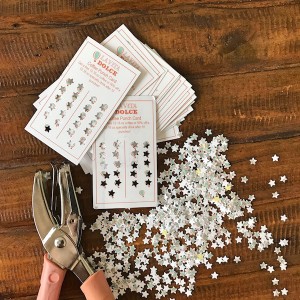A while back, we showcased a presentation, “Coffee Concoctions To Make You Feel Good,” at Southern Village Wellfest. The aim of our presentation was to help attendees learn how to best meet their dietary goals while enjoying a delicious cup of brew. We also wanted to encourage those who enjoy drinks with milk and flavors to discover new ways to mix it up so they have options when they want a new treat.
This series of posts covers key points made in the presentation. We’ve broken this digital summary into three posts, which will cover the following:
- Nutrition and health implications of black coffee (Post 1)
- How the nutrition of drinks with milk (think lattes, cappuccinos, etc.) varies with the type of milk used (Post 2)
- Healthy and creative ways to flavor and/or sweeten coffee (Post 3)
 This first post will discuss pure black coffee. If this is your favorite way to enjoy a cup of brew — keep on enjoying! A cup of black coffee has..
This first post will discuss pure black coffee. If this is your favorite way to enjoy a cup of brew — keep on enjoying! A cup of black coffee has..
- Five or fewer calories
- No fat
- No sugar
- No carbohydrates
Excellent.
But wait. Didn’t Facebook, or that guy, or someone at some point tell you that coffee is bad for you? Many of us have heard that coffee is somehow harmful. But you can rest at ease because available research indicates that coffee is NOT somehow bad for us.
(Here we are of course addressing the health implications of coffee in general and your doctor can advise on what is best for your individual needs/conditions.)
A few years ago, Aaron Carroll of The New York Times wrote an article called, “More Consensus on Coffee’s Effect on Health Than You Might Think,” in which he writes,
“[Coffee is] a completely reasonable addition to a healthy diet, with more potential benefits seen in research than almost any other beverage we’re consuming.”
In a 2012 article in The Atlantic Dr. Peter Martin, director of the Institute for Coffee Studies at Vanderbilt University (yes, this is an entire university institute dedicated to studying coffee — did I mention I’ve never been a prouder Vandy alumnus?) was quoted as saying:
“What I tell patients is, if you like coffee, go ahead and drink as much as you want and can.”
Miriam Nelson, a professor in the School of Nutrition Science and Policy at Tufts University and a member of the committee that wrote the latest dietary guidelines issued by the US government, said:
“We looked at all the science … we have found no negative, adverse effects on health when you drink up to three to five cups a day.”
 What might surprise you most is the amount of coffee consumption that constitutes a “good” range, or the amount defined as “moderate” in many studies. This isn’t one of those one-serving-is-good-but-two-is-horrible type deals. When it comes to coffee, go ahead and have 3 cups. Or four. Or five. Swiss cheese that coffee card.
What might surprise you most is the amount of coffee consumption that constitutes a “good” range, or the amount defined as “moderate” in many studies. This isn’t one of those one-serving-is-good-but-two-is-horrible type deals. When it comes to coffee, go ahead and have 3 cups. Or four. Or five. Swiss cheese that coffee card.
Looking more closely at meta-analyses examining coffee consumption studies reveals that drinking multiple cups of coffee is actually correlated with a host of health benefits.
A 2014 review and meta-analysis of studies looking at long-term consumption of coffee showed that those consuming three to five cups per day were at the lowest risk for developing cardiovascular disease.
A 2012 meta-analysis showed moderate coffee consumption to be correlated with a lower risk of heart failure. Here, the magic number was four cups per day to experience the lowest possible risk.
There have been a couple of meta-analyses, the first of which pooled data from eleven studies involving almost 480,000 participants, that have shown coffee consumption to reduce the risk of stroke.
Other research has shown coffee consumption linked to a lower risk of developing Parkinson’s Disease and type 2 diabetes.
So not only is coffee not bad for you, it could be good for you. There’s finally even national consensus (what!?) that coffee can be included in a healthy diet. The latest national dietary guidelines, 2015-2020 Dietary Guidelines for Americans, released in January 2016, states (for the first time ever in these guidelines), “Moderate coffee consumption (three to five 8-oz cups/day or providing up to 400 mg/day of caffeine) can be incorporated into healthy eating patterns.”
National consensus. Mind blown.
To wrap up our first post in this series, we’ll cover a specific aspect of coffee nutrition that we get a lot of questions about at the cafe.
Caffeine Content of Coffee
Our baristas get a lot of questions about the caffeine content of various coffee drinks. How much caffeine is in a 12 ounce cup of drip brew? What about a double espresso or a large latte? Does decaffeinated coffee have any caffeine?
Below is a chart using data from Mayo Clinic that shows the typical caffeine content of a variety of popular beverages.
| Beverage | Caffeine (mg) |
|---|---|
| Drip Coffee, 8 oz | 95-165 |
| Black Tea, 8 oz | 25-48 |
| Cola, 8 oz | 24-46 |
| Energy Drink, 8 oz | 27-164 |
| Espresso, 1 oz | 47-64 |
| Decaf Coffee, 8 oz | 2-5 |
Espresso, which is coffee brewed using high pressure, is traditionally served in one to two ounce servings. If you do the math, you’ll see that a double espresso (2 ounces of espresso) contains approximately the same amount of caffeine as 8 ounces of drip brew.
This is surprising to some, who assume that their 16 ounce latte with three shots has a TON of caffeine when in reality it has about as much as a twelve ounce drip coffee.
Caffeine in espresso is more concentrated per ounce of liquid, making it easier to caffeinate quickly if you’re drinking that espresso by itself. But if you want a 16 ounce drink with maximum caffeine, you should go for the drip brew over the 2-3 shot latte.
Also note that decaffeinated coffee does have a bit of caffeine.
And that’s all for this post. Our next post in this series is available here and covers milk options and nutrition.
